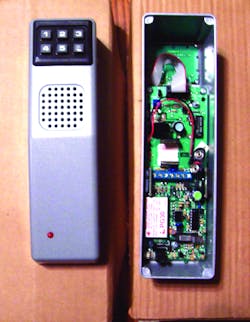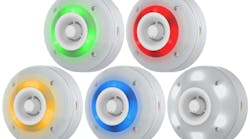Exit alarms provide a signal when the door upon which they are installed is opened without authorization. The term EXIT can refer to the fact that the device is mounted on an EXIT door, or it may classify the alarm device as one which signals unauthorized egress, as opposed to unauthorized entry. Exit alarms are members of the door alarm family.
Some typical situations where exit alarms are used include:
Hospitals, Custodial & Healthcare: To monitor movements of patients and clients
Retail: To discourage pilferage and the misuse of emergency exits (loss prevention)
Warehouses: To reduce inventory shrinkage
Municipal & Public Buildings/Spaces: To control movement through doors which might lead to dangerous or proprietary areas such as utility rooms, fire escapes or rooftops without having to physically lock the doors, thereby eliminating them as a means of emergency egress.
Schools & Nurseries: To control and monitor children’s movements and keep them within the premises
Hotels & Multiple Occupancies: To mitigate potential dangers from insecure openings, and passback of unauthorized individuals.
Exit alarms can be integrated into door control systems to enforce anti-passback system policies, where it is desired that a door only be used for normal usage in one direction, or when card readers are used for controlling movement through the door from two directions, but obstructing egress would violate building codes, so an audible alarm is used as a deterrent.
The following devices can be considered exit alarms:
• Electronic access control systems with provision for exit alarm annunciation
• Standalone audible exit alarms
• Audible exit alarms with integral locking
• Locking exit devices with audible exit alarms
• Other locking devices with exit alarms and delayed egress
In electronic access control, entry is typically controlled with a card reader or keypad, and egress is usually unrestricted, but such actions are signaled to the control system with a request-to-exit (REX) switch. If the subject door is opened without a valid card read or a REX signal, a forced door alarm results. An electronic access control system can be provisioned with a local annunciator, which identifies the location of the violation and lets the violator know he has been detected.
The usage of the door, the nature of the occupancy and the security issue you are being requested to address will all determine the type of door alarm you will use and how successful a solution it will provide your customer.
When specifying any locking device which is used on an exit, fire door or along the path of egress, the code requirements for that opening and occupancy must be determined, and only approved hardware be used. The standard for exit alarms is covered by ANSI/BHMA A156.29-200.
Be sure that the device you plan to install is appropriate for the environment. For example, in some applications such as hospital wards, a loud audible signal can be disturbing to patients and cause panic and other issues. A battery powered door alarm is perhaps the simplest type of exit alarm. It requires no wiring and mounts on the subject door and frame along with a door sensor.
Some exit alarms can be readily used for the purpose of monitoring a propped or ajar door, for example if a door remains open after an authorized usage such as the door getting stuck or deliberately blocked from reclosing.
Door alarm systems are available which will allow the door to be opened long enough for a typical entry or exit, but once that time envelope has been exceeded and the door is still ajar, an alarm will sound.
Even if the premises has an alarm system, most alarm systems are not connected to every opening in the premises, and more than likely the alarm system is only activated at night. Few premises alarm systems are supplied with audible alarm (local alarm) at an individual door.
Sometimes it is necessary to deploy a door alarm in a hurry due to a change in building usage or revised risk assessment. A door alarm can be used in conjunction with other security measures such as the premises alarm so that a door opening can be handled without involving a central station or the entire alarm system.
Standalone access control devices, whether key, keypad or credential based, are typically unable to provide real time reporting or local audible annunciation. Even those systems which provide audit trails of legal and illegal door usage, the information must be uploaded and evaluated.
A door alarm system may be implemented which will not only alert if a violation occurs, but can also trigger a CCTV camera to record the event and enable it to be viewed from CCTV monitors or even workstations on the network virtually anywhere. Equipping a door alarm system with a wireless alarm transmitter further extends the functionality of the door alarm, the access control system and the perimeter alarm system.
Delayed Egress Systems also provide exit alarm and door locking functionality, along with inhibiting egress to assist authorities to gain control of the situation. Examples would be a shoplifting in progress or a wandering Alzheimer’s patient.
The NFPA #101 Life Safety Code Special Locking Arrangements (as well as other building codes) dictate the required features of a delayed egress system, and all delayed egress systems are subject to approval by the LAHJ.
Delayed egress systems present a compromise solution to openings where both security and life safety are required. The compromise is the delayed egress locking arrangement which basically does the following:
Doors unlock upon actuation of the fire protection system
Doors unlock upon loss of power controlling the locking mechanism
Door unlock upon disablement of the fire protection system
An irreversible process releases the lock within 15 seconds upon application to the release device (15 lb. for not more than 3 seconds)
Initiation of the release process activates an audible signal in the vicinity of the door
After release, locking shall be by manual means only
Signage on egress side of door reading, “Push until alarm sounds. Door can be opened in 15 seconds.” ALARM LOCK
Alarmlock’s Model PG30 Narrow Keypad Door Alarm Center offers a variety of features for custom applications. Other versions of this unit utilize a mortise cylinder instead of a keypad. Features include:
Digital codes for Master, Management and Passage (used for Auto-Arming)
Three security levels for high security, unattended applications and flexible control for delivery doors, etc.
Three Programmable 95db siren styles: sweep, pulsed, and steady audible low battery warning
For optional use with the PG30, the PGKPD low-profile, brushed aluminum finished accessory provides all functions of the PG30 from the outside of the door.
Alarm Lock also offers the Sirenlock™ Models 250, 260, 700, and 710 UL Listed panic alarm deadbolt devices which restrict unauthorized use of exit doors by sounding an alarm, while providing instant egress in emergencies. Weatherproof electronic alarmed panic locks 700x28WP and 250x28WP are suitable for outdoor use.
Von Duprin
Von Duprin’s Chexit is designed for use on delayed exit applications. The Chexit system is ideal for controlled areas. This concept in delayed exit systems combines life safety with the needs of security and meets all requirements of NFPA 101 for “Special Locking Arrangement”
The Chexit system will keep an exit door secured for a 15-second period, yet tied into the fire alarm system, it will release immediately when an alarm condition exists. All controls, auxiliary locking, local alarm, and remote signaling output are self-contained in the Chexit assembly, providing safe, secure and easy to install door control hardware.
The Chexit system is ideal for highly controlled areas such as airports, hospitals, government facilities and development labs, retail stores, libraries and security facilities.
Models CX98 and CX99 are available for rim, mortise lock and surface and concealed vertical rod mounting styles. CX33A and CX35A are available on rim mounting style only.
Chexit is UL listed for use on panic or fire exit doors 3 or 4 feet wide.
In addition to the Chexit Bar a typical complete Chexit system requires a PS873 power supply and a power transfer which provides power and signal connections form the fixed door frame to the door and the Chexit unit.
DETEX
The Detex Value Series V40xEBxW weatherized alarmed rim exit device is a weather-resistant loss prevention hardware designed for use in outdoor or wet environments. The design exceeds MIL-STD810F, Method 506.4, Driving Rain Test, which is simulated 4 inch per hour with 40mph wind, and MIL-STD 810F, Method 509.4, Salt Fog Test which simulates coastal corrosive atmospheric environments. This ruggedness translates to less maintenance issues in less difficult environments.
The unit is aesthetically appealing and suitable for any décor. Any five, six, or 7 pin standard or IC mortise cylinder either a standard cam may be used. The V40xEBxW meets building code requirements for panic and fire exit hardware and may be integrated with other loss prevention equipment. The durable V40xEBxW withstands more than 1400 lbs of static load (pull) force.
A patent pending design enables perfect alignment with the door and frame without a paper template, speeding installation time and minimizing damage to the door or product.
The bolt is stainless and self-latching and the end cap is angled to deflect damage. Plated Steel, anodized aluminum and ABS components endure heavy use and exposure to the elements. Cylinder-dogging is a standard feature. The unit also features bright ‘theft-deterring’ false-alarm reducing highly visible signage, designed to resist fading from exposure to IR (infrared form natural sunlight)
Features include:
• Powered by standard 9-volt battery
• Tamper-resistant, immersion-proof security switches
• Approximately 100 Decibel alarm
• Indefinite alarm requiring manual re-arm, or selectable alarm time-out, 2 min., 10 min., or 20 minutes. Also auto re-arm feature.
• Selectable delayed arming feature (15 or 60 seconds) for arming after door doses
• Red flashing LED warning when unit is not armed.
• Remote signal switch activates other devices when alarm sounds
• Base plates available in brushed aluminum and black (BK) anodized finishes
• Can be used on 3’ and 4’ doors and gates
Other Value Series models include 9-valt battery alarm, 12-VAC alarm. delayed egress, electronic switching and electronic integration devices.
STI
The STI-6400 Exit Stopper® multifunction door alarm alerts you to any unauthorized exits/entries through emergency exit doors and rear doors. It serves as an inexpensive security device and helps stop theft as well.
If the protected door is opened, the electronic Exit Stopper emits an ear piercing alarm for 10 beeps, 30 seconds, three minutes or continuously (as preset by the user). A key operated override will silence the alarm and allow authorized exits. Exit Stopper is fitted with a long life alkaline battery. It is available in red or green for almost any type of door, mounting or installation.
Additional features include:
• Highly visible “stop sign” design acts as a deterrent.
• Sounds a powerful 105 dB warning horn when activated(95 dB low volume setting can be set if desired).
• Virtually indestructible polycarbonate housing.
• May be programmed for 15-second entry delay or immediate alarm.
• In annunciation mode, alarm announces door entry with a set of 10 beeps.
• Unit is completely self-contained.
• May be mounted on top, right, left or next to almost any door.
• Detects both unauthorized exits and entries.
• Easy to install and practical for all emergency doors.
• Compact patented design 5.375 in. (137mm) in diameter and 2 in. (51mm) deep.
• Also available in green housing to comply with newer standards (STI 6400-G).






